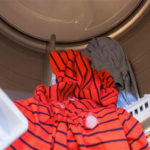Why should you place a wooden spoon horizontally on a boiling pot?
This small tip will help you be more proactive when encountering an urgent boiling situation, minimizing the phenomenon of water overflowing from the pot.

When boiling water, especially bone broth, crab soup, soy milk, or even boiling water…, just a little distraction will require a lot of effort to clean the kitchen because the water spills out and drips down the stove. Not to mention, the spilled food is also a waste.
This phenomenon occurs because there is always a certain amount of dissolved air in water. When you cook something and reach the boiling point, the increasing temperature will reduce this dissolved state and the hot water will quickly transform from liquid to gas.
The bubbles formed when boiling water are the steam formed right inside the liquid. The higher the temperature, the more gas escapes, adheres to the pot wall, and rises to the water surface.
The longer it boils, the more bubbles will increase on the surface until it overflows. That’s why you should place a wooden spoon horizontally on a boiling pot.
At this time, to prevent the food in the pot from overflowing, place a wooden spoon on top. If the liquid in the pot starts to overflow too high, the wooden spoon will prevent them from spilling out. The physical presence of the spoon will break the surface of the bubbles, preventing them from overflowing the pot wall.

Fundamentally, bubbles will burst when they encounter something hydrophobic (water-repellent) and a wooden spoon is definitely suitable for breaking that layer of bubbles.
In addition, wood is a poor conductor of heat and will only work for a limited time. Therefore, when in contact with the bubbles of water at 100 degrees Celsius, the low temperature of the spoon will immediately condense the steam back into water droplets, preventing it from continuing to overflow.
This is in stark contrast to using a metal spoon. Metal is a very good conductor of heat. When placed in the pot, it will heat up – sometimes even faster than the water in the pot. At that time, the water in contact with the smooth, hot surface of the metal spoon will quickly overflow.
However, note that if the water overflows multiple times, it will wet the wooden spoon, making it hot and gradually losing its effect. Therefore, after a period of time, you should return to turn off the stove instead of relying entirely on the prevention of the wooden spoon. The longer the water boils, the more bubbles will continue to form and the pot will boil and overflow.
Note: To make the best use of this trick, when placing a wooden spoon horizontally on a boiling pot, you should choose a large-sized spoon. Generally, this trick applies to all cooking cases where water and bubbles are easily spilled out of the pot. If you need to go out for a short time, you can apply this small trick.



































